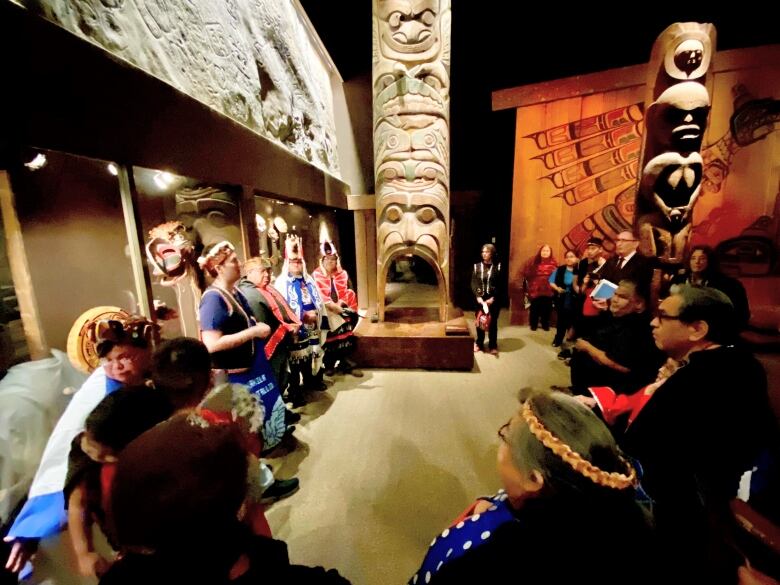B.C. government put on defensive after 'tone deaf' $789M museum upgrade announcement
John Horgan's NDP government has faced blistering criticism for its plans for a new Royal B.C. Museum

At a press conference last week, Premier John Horgan announced a $789-million rebuild of the Royal B.C. Museum with a smile and one of his trademark dad jokes.
"I would definitely characterize that as a mammoth announcement for the people of British Columbia," he said, a reference to the stuffed woolly creature that is the museum's best-known exhibit.
The smile was soon gone, though, as what started as a feel-good announcement turned into a political own-goal unlike almost any other Horgan has faced since becoming premier in 2017.
Critics hammered the government on the high price for the upgrade, pointing out that B.C. is dealing with a family doctor shortage, skyrocketing gas prices and an affordability crisis. Within a week, Horgan was apologizing for turning the museum into a "political football," in his own words, promising to release the full business case for the costly renovations in the days ahead.
But opponents and supporters alike are uncertain British Columbians can be convinced.
"If the NDP loses the next election, people will go back and trace it to this announcement," said Martyn Brown, who was chief of staff to former premier Gordon Campbell.
Former NDP cabinet minister Elizabeth Cull called the announcement "tone deaf," even if she thought funding for museums and things like health care is not "an either-or situation."
And with the project expected to last until at least 2030, it has handed plenty of ammunition to new B.C. Liberal Leader Kevin Falcon.
'A vanity project'
Opposition criticism has been relentless, with the B.C. Liberals using phrases such as "vanity project" or "vanity museum project" more than 60 times in the legislature from Monday to Thursday, according to B.C. Hansard transcripts.
Falcon told reporters he was "massively disappointed" with the timing and promised to cancel the project should he become premier in the next election, slated to take place on or before Oct. 19, 2024.

Tourism Minister Melanie Mark was tasked with defending the price tag, pointing out that the project is spread out over several years and involves six hectares of land, five buildings and seven million objects that she said would stretch more than 27 kilometres if they were laid end to end.
The province has said the 54-year-old building that houses the current museum is seismically unsound, filled with asbestos and lacks the ability to safely preserve most of its collections with current best practices. It is being completely demolished and replaced with a state-of-the-art facility able to withstand coastal floods and earthquakes, something Mark warned could be devastating to the current building.
"Two floors [of the current museum] are under sea level ... if there was a flood, we would be wiping out our collective history," Mark said.
In addition, a satellite facility for research and storage in the neighbouring community of Colwood, announced two years ago, has been budgeted at $224 million.
The museum will be closed from September 2022 until at least 2030, at a time when tourism-based businesses recovering from the pandemic are counting on the museum to draw visitors to the city.
Bruce Williams, CEO of the Greater Victoria Chamber of Commerce, said while he understood the need for the upgrades he was surprised by the long-term closure.
"We heard it would be three to five years," he said.
Tim Willis, a Victoria-based museum consultant who once worked at the Royal B.C. Museum, said while he was supportive of funding the project in principle, he was "troubled" by the length of the closure, adding that there could be delays and cost overruns.
"I think it's entirely possible, as we've experienced with many other large capital projects, that this will inflate over time," Willis said.

'What about us?'
Another source of criticism came from some of the smaller museum and heritage sites around the province.
Tumbler Ridge Mayor Keith Bertrand said the funding was a "kick in the teeth" for people in his community, who are attempting to find money to keep the community's museum, home to the province's largest dinosaur fossil museum, open.
And Kelly Black, executive director of Victoria's Point Ellice House, felt the funding was "disproportionate" compared to what other historic sites in the province receive.
Places like Point Ellice House have been on "life support" for decades, Black said. A fraction of the proposed budget for the new museum could fund all provincial heritage properties for a decade.
"[We're] going, 'Whoa, hey, what about us?'" he said.

Some Indigenous leaders suggested part of the money could be better spent on sending objects in the museum's collection back to their home communities.
"They have stolen artifacts that belong to Indigenous groups and First Nations and have not expressed the intention of returning them or asked how we would like to display them or what we would like to see done with them," Tŝilhqot'in Chief Joe Alphonse said.
He pointed to the case of a hereditary chief of the Nuxalk First Nation filing a lawsuit earlier this year stating that he is still waiting for the return of a totem pole carved by his great-grandfather.
Mark, who is part Nisga'a, Gitxsan, Cree and Ojibway, has called the project "reconciliation in action," promising the renovation would also include partnerships with First Nations to better tell their stories.
Barbara Todd Hager, acting head of Indigenous Collections and Repatriation, said the museum is under new leadership and repatriation takes time.
"We want to make sure we get it right and we work really closely with communities in the whole process," she said.
With files from Sterling Eyford, On the Island and The Canadian Press

